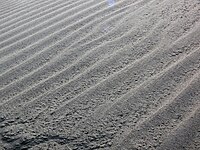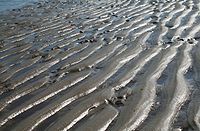Ripple marks
In geology, ripple marks are sedimentary structures (i.e. bedforms of the lower flow regime) and indicate agitation by water (current or waves) or wind.
Straight ripples generate cross-laminae that all dip in the same direction, and lay in the same plane. These forms of ripples are constructed by unidirectional flow of the current.
Sinuous ripples generate cross-laminae that are curvy. They show a pattern of curving up and down as shown in picture. Sinuous ripples produce trough cross lamination. All laminae formed under this type of ripple dip at an angle to the flow as well as downstream. These are also formed by unidirectional flow of current.
Catenary ripples generate cross-laminae that are curvy but have a unidirectional swoop. They show a pattern similar to what a repeated "W" would look like. Like the sinuous ripples, this form of ripple is created by unidirectional flow with the dip at an angle to the flow as well as downstream.
...
Wikipedia



